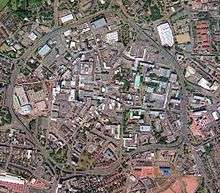Coventry ring road
The A4053, commonly known as the Coventry ring road, is a ring road in Coventry, England, which forms a complete dual carriageway loop around the city centre. The road encompasses the old and new Coventry Cathedrals, Coventry University, West Orchard and Cathedral Lanes Shopping Centres, Coventry Skydome Arena, and many other businesses.
| |
|---|---|
| Route information | |
| Length | 2.25 mi[1] (3.62 km) |
| History | Constructed 1962-1974 |
| Major junctions | |
| Orbital around Coventry | |
| Road network | |

Unlike many other city centre ring roads, Coventry ring road is made up of entirely grade-separated junctions except for one roundabout, this leads to the junctions being extremely close together and in effect one junction leads into another at many points.
.jpg)
_at_sunset.jpg)
After the Second World War, during which most of Coventry city centre was destroyed by the Luftwaffe, the rising level of traffic on the city's roads resulted in plans for the narrow city centre streets to be bypassed with a circular ring road, a type of road which was soon to be commonplace in cities and towns across the United Kingdom. Construction began in the late 1950s; the first phase of the road was ready for use in 1962. It was completed in 1974, 12 years after the first section of ring road opened and some 20 years after the ring road was first planned.
Junctions
- Roundabout beginning of Ringway Swanswell. Junction with Foleshill Road (B4113).
- Junction with B4109. Beginning of Ringway Whitefriars.
- Junction with A4600.
- Junction with A4114(S). Beginning of Ringway St. Johns.
- Junction with minor roads (leading to B4544). Beginning of Ringway St. Patricks.
- Junction with A429. Beginning of Ringway Queens.
- Junction with Butts Road (B4101). Beginning of Ringway Rudge.
- Junction with A4114(N). Beginning of Ringway Hill Cross.
- Junction with B4098. Beginning of Ringway St. Nicholas.
